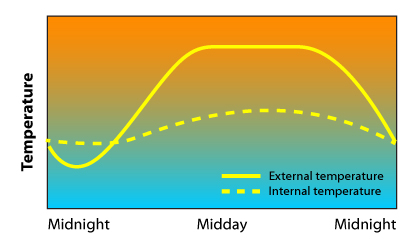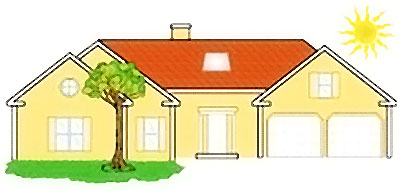 |
|
| |
Cooling Tips |
|
| |
|
| |
Coolbatts is an affordable and hassle-free solution for cooler homes in Malaysia's hot tropical climate. It's actually the smartest decision you'll ever make. Many homes in Klang, Subang Jaya, Shah Alam, Petaling Jaya, Kuala Lumpur, Seremban and Pahang have enjoyed the cooling benefits of Coolbatts.
With Coolbatts, indoor temperature can be lowered by 2°C to 5°C and thus, air-conditioning running costs reduced by as much as 25 per cent.
What's more, Coolbatts is water and vermin resistant, fire-safe and reduces external noise intrusion through ceilings.
|
| |
|
| |
It's actually the smartest decision you'll ever make. With Coolbatts you and your family can enjoy up to 5°C reduction and have a cooler home.
|
| |
|
|
Close blinds and awnings especially in areas where the sunlight hits the most. |
|
|
Close all doors and windows in the room when you switch on the air-conditioner. |
|
|
If you do not have an air-conditioner in the room, open the window at night to allow cooler air to ventilate your house, while keeping doors and windows closed during the day to keep the hot air out. |
|
|
Tint or shade all windows exposed to sunlight. |
|
| |
|
| |
Take control of your home’s environment
In simple terms, taking control of heat transfer is all about smoothing out the temperature fluctuation that occurs on a hot day by slowing the rate at which a home heats up inside during the day and speeding up its cooling down rate in the late afternoon and evening.
|
| |

|
| |
Soothing out the daily temperature fluctuation |
| |
|
| |
| |
In the same way that an insulated ice-box keeps cold inside, quality Coolbatts with guaranteed thermal resistance (R-value) will dramatically slow heat transfer in your home. |
| |
|
| |
| |
 |
| |
Direct Sun (radiation)
Reducing the impact of sunlight coming into your home will have a dramatic effect on internal temperatures. |
| |
 |
| |
Windows
North, east and west facing windows are the ones to watch.
• External shutters provide the best protection as they stop the hot sun before it can heat your window glass.
• Venetians, holland and vertical blinds fit neatly inside the window cavity and help to reflect direct sunlight.
• Consider reflective window tinting (particularly west-facing windows) where light, but not heat from a window is desirable.
Tip: A combination of sheer, fixed curtains and heavy retractable drapes gives a lot of flexibility |
| |
 |
| |
Your Garden
Greenery provides shade and will not reflect as much heat as a concrete path!
• Plant deciduous trees to provide shade
• Use potted plants where there is no garden bed
• Lawn and other ground cover reduces reflected heat |
| |
 |
| |
Windows & Doors
Search for draughts! Hot air can easily come in under doors and around windows.
• Install draught seals on outside doors.
• Using weather-seal around windows and doors will minimise air escape.
• Seal any gaps between skirting boards and floors with a caulking compound.
Tip: For rooms with fixed vent windows such as toilet/bathrooms, keep the door shut or fit auto-closers! |
| |
 |
| |
Roofs and Walls
• 70% of a home’s heat comes from the roof, 30% through the walls.
• Install ceiling insulation to slow heat transfer from your roof.
• Install eave vents on the southern side of your home and a roof ventilator to expel the heat built up in your roof space.
• Consider Coolbatts insulation to slow heat transfer from external walls.
• Paint external walls a lighter colour to reflect heat.
Tip: A quick early evening hose down of hot brick walls will help to cool things down. |
| |
| |
| |
Changeover Times
Take note of the two times, morning and afternoon, that the outside temperature is the same as inside.
• In the morning, close windows and doors to keep the cool air inside and close blinds and awnings on the east, north and west as the sun moves throughout the day
• At night, open windows and doors to let in cool breezes.
• Get to know which doors in your home provide the best natural air flow.
|
| |
 |
| |
Air Conditioning
An easy comfort decision which can be expensive to run if you’re not careful.
• Install the unit on the shaded side of your home, if practical.
• Limit the area you are cooling by closing doors to the rest of the house.
• Use your air conditioner’s thermostat or timer or turn it off at night and when you’re out.
• Consider an air transfer ducting system between specific rooms.
Tip: An insulated home will retain its coolness for much longer periods, allowing you to run your air conditioner for less, saving energy, money and the environment. |
| |
 |
| |
Things are heating up!
Scientists predict that the earth's average temperature may increase by a further 6°C by the year 2100. But take heart, by understanding how heat works and learning to tame Mother Nature, you can make a real improvement in your year-round comfort. (And make a positive contribution to global warming at the same time!) |
| |
|
| |
|
| |
|